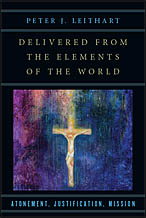"Delivered from the Elements of the World" by Peter J. Leithart. A Review
Delivered from the Elements of the World:
Atonement, Justification, Mission
Peter J. Leithart
IVP Academic (InterVarsity Press)
PO Box 1400
Downers Grove, IL 60515
ISBN: 978-0-8308-5126-3; $30.00; March 2016
Reviewed by Rev. Dr. Michael Philliber for
Deus Misereatur
Imaginative and
Ingenious; 5 Stars out of 5
My family and I
have changed the rules of the game. After playing UNO for years the standard way, we spiced it up with a few extra
twists and turns. Now you can stack the “Draw Four” cards, player by player, until
there are no more to be played, thus potentially leaving the last participant
who doesn’t have any “Draw Four” cards under a substantial pile. And there are other
adventurous variations we’ve added, all of which leave the game structurally the
same while internally distinctive. This
is the kind of thing Peter J. Leithart, president of Theopolis Institute, adjunct
senior fellow of theology at New Saint Andrews College in Moscow, Idaho,
columnists for First Things and
accomplished author, does in his new 369 page paperback, “Delivered from the Elements of the World:
Atonement, Justification, Mission.” Though he stays within the contours of
orthodox Christianity, and specifically the Reformed stream, yet he flavors things
with some zesty curls and curves. The
whole undertaking swirls around a phrase and concept penned by St. Paul in
Galatians 4, “the elementary principles of the world” (ta stoicheia tou kosmou). It is an academic, theological and
pastoral read, chock-full of footnotes and mild technicalities, that aims to
begin unpacking what it means to be delivered from the elementary principles of
the world; how, “according to the apostle, Jesus delivered Jews and Gentiles
from the elemental world into a new social world that operates by different
sociophysical laws” (26).
“Delivered from
the Elements of the World” falls into four segments that guide the reader from
a recognition of what the elements of the world are, to the justice of God,
through the category of justification, and ends up in missions. The volume then
concludes with three important appendices that are essential addendums to
specific material presented in the book. Throughout the manuscript are numerous footnotes,
some taking up a whole page, but enough to make an academic grin and the
average reader groan.
In essence, the
author is taking Anselm’s question, Cur
Deus Homo? (Why the God-man?) and asking it as a question of social and
political theology; “Cur Deus Homo
for the salvation of human society in
history” (13)? And his reason is that “if the gospel is about the salvation
of humanity it must carry a message of hope for the salvation of human society”
(14). Therefore, according to the author, atonement and justification are both churchly
(ecclesiological), forming a “new humanity
with a renewed socioreligious physis.”
For, the “church is, in fact, the
first form of transformed human society. This is why the God-man must die and
rise: if society is to be saved, there must be a church; if there is going to
be a church, there must be a Messiah dead and risen.” This all means, then,
that if “the world is to be saved, atonement must become a social fact. If it
is going to be plausible, atonement theology must be social theory” (218). Therefore,
because baptism binds together diverse humans across national, ethnic and
social lines then it “is one of the rites that effects the social salvation of humanity” (222). But also, adversely,
a splintered Church – splintered by politics, nationalism, ethnicity, etc. – is
a Church that has slipped back under the elementary principles of the world, into
what Leithart denominates as “Galatianism” (258-281). And that is bad news, not
only for the Church, but also for the world.
In the end, the
author wants us to grasp that the incarnation, life, death, resurrection and
ascension of Jesus has brought about a regime change that has social
consequences. The world is under new management; it is no longer under ta
stoicheia tou kosmou, but
under the Lordship of Jesus. And this change impacts all humankind (203-4),
even affecting the shape of world religions like Buddhism, Hinduism, Islam and
Judaism (239-257).
Though I have not
done justice to “Delivered from the Elements of the World” in this short
review, passing over several crucial aspects and arguments, yet hopefully I
have given the proper sense. There will be items in the book readers will likely
argue with, as I did. And to quote the book at an ordination exam will probably
incite riots and raise a ruckus; nevertheless it is a volume worth engaging and
tackling, especially if the reader will approach it not as a definitive divinity
declaration, but rather as a speculative thought-experiment into how big might
the atonement actually be! John Murray, in his article on “The Atonement” only
touched the margins of this subject when he delved into the extent of the
atonement. Leithart takes the ball and runs it further down the field. This is
a book highly worth obtaining, reading and discussing.
Feel free to re-plublish or re-post this review; but please give credit where credit is due. Mike




Comments